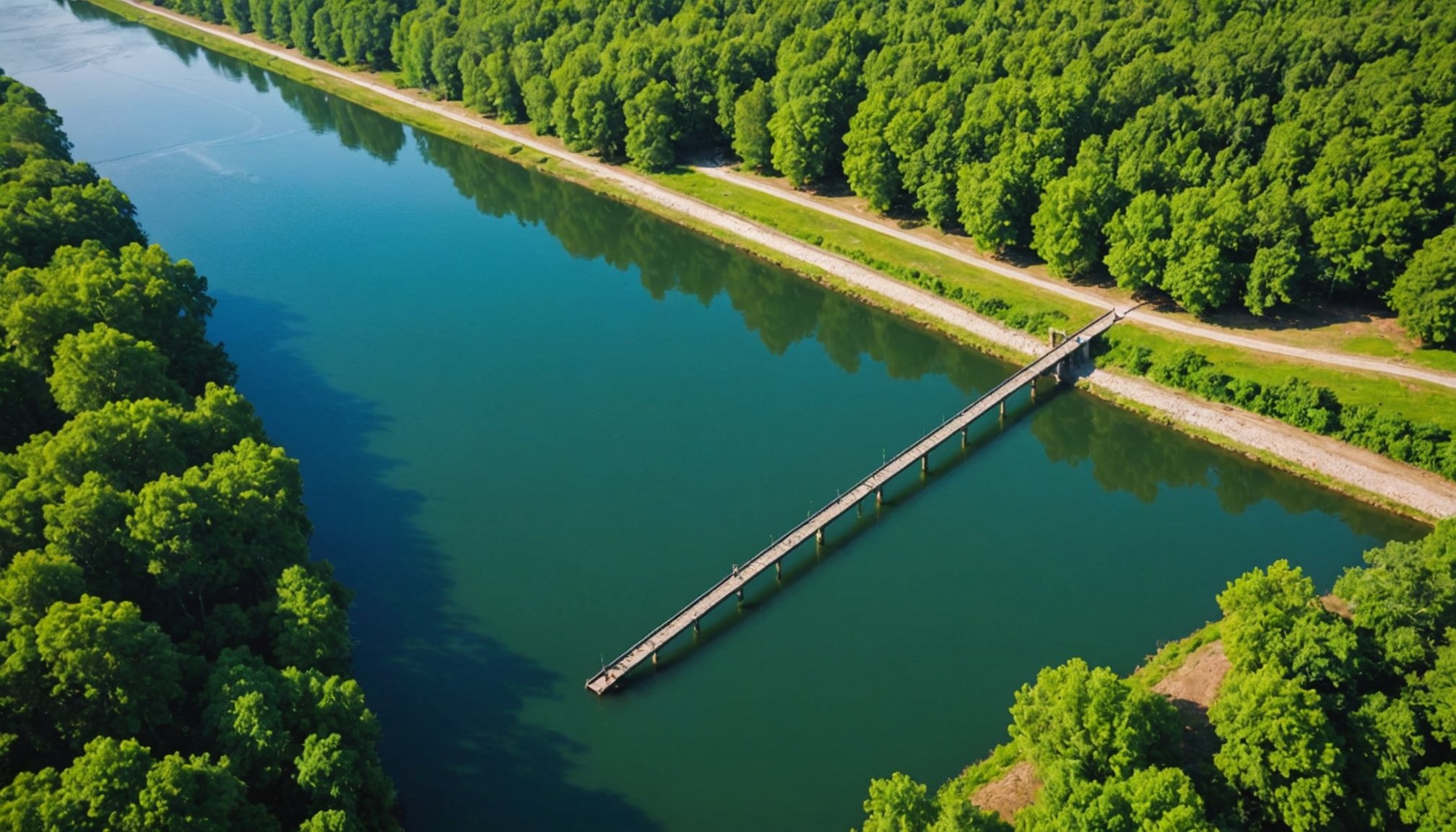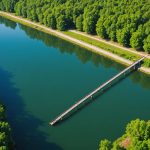Have you ever wondered how we manage to keep our rivers and streams in check? Well, mastering fluvial gauging is the key to efficient water management solutions. This fascinating field combines science, technology, and a bit of artistry to ensure that our water resources are monitored and managed effectively. Let’s dive into the world of fluvial gauging and explore how it can revolutionize water management.
Understanding fluvial gauging
Fluvial gauging, at its core, is the process of measuring the flow of water in rivers and streams. It’s a critical component of water management, helping us understand how much water is available, how it’s moving, and how we can best use it. But why is it so important?
Cela peut vous intéresser : Top stratégies pour maximiser les ventes en magasin
The science behind fluvial gauging
The science of fluvial gauging involves a range of techniques and tools designed to measure water flow accurately. From traditional methods like current meters to advanced technologies like acoustic Doppler current profilers (ADCPs), the goal is to gather precise data on water velocity, depth, and discharge.
« Fluvial gauging is not just about measuring water; it’s about understanding the dynamic nature of our rivers and how they interact with the landscape, » says Dr. Jane Rivers, a leading hydrologist. This understanding is crucial for predicting floods, managing water resources, and ensuring ecological balance.
Lire également : Aide à domicile à bordeaux : un soutien personnalisé et fiable
Importance of accurate measurements
Accurate measurements are the backbone of effective water management. They help us:
- Predict and manage floods: By understanding the flow rates and volumes of rivers, we can better predict when and where floods might occur, allowing for timely evacuations and flood mitigation strategies.
- Allocate water resources: Accurate data helps in distributing water for agriculture, industry, and domestic use, ensuring that all sectors have access to the water they need without depleting the resource.
- Protect ecosystems: Rivers are vital to ecosystems, and maintaining the right flow rates is essential for the health of aquatic life and the surrounding environment.
- Plan infrastructure: From dams to irrigation systems, accurate fluvial data is crucial for designing and maintaining water-related infrastructure.
- Monitor climate change: Changes in river flows can be indicators of broader climatic shifts, helping us understand and respond to global environmental changes.
Techniques and technologies in fluvial gauging
So, how do we actually measure the flow of water in rivers? Let’s explore some of the key techniques and technologies that make fluvial gauging possible.
Traditional methods
Traditional methods of fluvial gauging have been around for decades and are still widely used due to their reliability and simplicity. One common method is the use of current meters, which are mechanical devices that measure water velocity by counting the rotations of a propeller or impeller as it’s lowered into the water.
Another traditional technique is the float method, where a floating object is tracked over a known distance to estimate water velocity. While these methods are straightforward, they can be labor-intensive and may not provide the precision needed for modern water management challenges.
Advanced technologies
Modern technology has brought significant advancements to fluvial gauging. One of the most exciting developments is the use of acoustic Doppler current profilers (ADCPs). These devices use sound waves to measure water velocity at multiple points across a river’s cross-section, providing a detailed picture of the flow.
« ADCPs have revolutionized our ability to measure river flows with unprecedented accuracy, » notes Dr. Mark Stream, a researcher at the National Water Research Institute. Other advanced technologies include remote sensing techniques, which use satellites and drones to monitor river flows from above, and in-situ sensors that can be deployed directly in the water to provide real-time data.
Challenges in fluvial gauging
While fluvial gauging is essential for water management, it’s not without its challenges. Let’s look at some of the hurdles that professionals in this field face and how they’re working to overcome them.
Environmental variability
Rivers are dynamic systems, constantly changing due to factors like rainfall, snowmelt, and human activity. This variability can make it difficult to get consistent and accurate measurements. For example, during heavy rain, the water level can rise rapidly, making it challenging to deploy traditional gauging equipment safely.
« Dealing with the unpredictability of river flows is one of the biggest challenges in fluvial gauging, » explains Dr. Sarah Brook, a hydrologist at the Environmental Protection Agency. To address this, researchers are developing more robust and adaptable technologies that can handle a wide range of environmental conditions.
Technological limitations
While advanced technologies like ADCPs offer incredible precision, they can be expensive and require specialized training to operate. This can limit their use in some regions, particularly in developing countries where resources are scarce.
Additionally, some technologies may struggle in certain environments. For instance, ADCPs can be less effective in shallow or turbulent waters. Researchers are working on improving these technologies to make them more versatile and accessible.
Case studies and practical applications
Let’s take a look at some real-world examples of how fluvial gauging is being used to improve water management and solve pressing environmental issues.
The Colorado River Basin
The Colorado River Basin is a prime example of how fluvial gauging can be used to manage water resources effectively. The basin spans seven U.S. states and Mexico, and it’s a critical source of water for millions of people.
By using a combination of traditional and advanced gauging techniques, water managers have been able to monitor the river’s flow closely, helping them allocate water more efficiently and predict droughts and floods. This has been crucial for sustaining agriculture, urban water supplies, and the river’s delicate ecosystem.
« Fluvial gauging has been instrumental in helping us manage the Colorado River’s resources sustainably, » says Maria Lake, a water manager at the Colorado River Water Conservation District.
The Ganges River
In India, the Ganges River is vital for millions of people, but it’s also prone to severe flooding. Fluvial gauging has been used to develop early warning systems that can predict when floods are likely to occur, allowing for timely evacuations and flood mitigation measures.
Researchers have deployed a network of in-situ sensors and remote sensing technologies to monitor the river’s flow in real-time. This data is then used to create predictive models that help authorities respond to floods more effectively.
« The use of fluvial gauging in the Ganges has saved countless lives and helped us better manage this vital resource, » says Dr. Ravi Gupta, a hydrologist at the Indian Institute of Technology.
Future trends in fluvial gauging
As we look to the future, what innovations and trends can we expect to see in the field of fluvial gauging? Let’s explore some of the exciting developments on the horizon.
Integration of AI and machine learning
Artificial intelligence (AI) and machine learning are set to play a significant role in the future of fluvial gauging. These technologies can analyze vast amounts of data quickly and accurately, helping to improve the precision of flow measurements and the reliability of predictive models.
For example, AI algorithms can be used to process data from remote sensing technologies, identifying patterns and trends that might be missed by human analysts. This can lead to more accurate flood predictions and better water resource management.
Enhanced remote sensing capabilities
Remote sensing technologies are becoming increasingly sophisticated, with new satellites and drones offering higher resolution and more frequent data collection. This will allow for more detailed monitoring of river flows and the ability to track changes in real-time.
One exciting development is the use of hyperspectral imaging, which can provide detailed information about water quality and sediment loads, helping to improve our understanding of river dynamics and their impact on the environment.
Community-based monitoring
Another trend is the rise of community-based monitoring initiatives, where local residents are trained to collect data on river flows using simple, affordable tools. This can help fill gaps in official monitoring networks and provide valuable data for water management.
« Community-based monitoring empowers local communities to take an active role in managing their water resources, » says Dr. Lisa Creek, a researcher at the University of Water Studies. This approach can also help build public awareness and support for water conservation efforts.
Comparative analysis of fluvial gauging technologies
To help you understand the different technologies used in fluvial gauging, let’s compare some of the most common methods in a table:
| Technology | Accuracy | Cost | Environmental Suitability | Real-time Data |
|---|---|---|---|---|
| Current Meters | Moderate | Low | Good in calm waters | No |
| Acoustic Doppler Current Profilers (ADCPs) | High | High | Good in most conditions | Yes |
| Remote Sensing | Variable | Medium to High | Excellent for large areas | Yes |
Practical tips for mastering fluvial gauging
Now that we’ve covered the basics of fluvial gauging, here are some practical tips to help you master this essential skill:
Stay updated with the latest technologies
Technology in fluvial gauging is constantly evolving. Make sure to stay informed about the latest tools and techniques by attending workshops, reading industry publications, and networking with other professionals in the field.
Understand your river’s unique characteristics
Every river is different, with its own flow patterns, sediment loads, and environmental challenges. Take the time to study the specific characteristics of the rivers you’re working with to ensure your measurements are as accurate as possible.
Collaborate with local communities
Engaging with local communities can provide valuable insights into river dynamics and help you gather more comprehensive data. Consider setting up community-based monitoring programs to enhance your data collection efforts.
Use a combination of methods
No single method of fluvial gauging is perfect for all situations. Use a combination of traditional and advanced techniques to get the most accurate and reliable data. For example, you might use ADCPs for detailed flow measurements and remote sensing for broader monitoring.
Ensure data quality and consistency
Maintaining high data quality is crucial for effective water management. Implement rigorous quality control measures, such as regular calibration of equipment and cross-checking data from different sources, to ensure your measurements are consistent and reliable.
In conclusion, mastering fluvial gauging is essential for efficient water management solutions. By understanding the science behind it, staying updated with the latest technologies, and applying practical tips, you can play a vital role in ensuring our rivers are managed sustainably for future generations. So, are you ready to dive into the world of fluvial gauging and make a difference?












